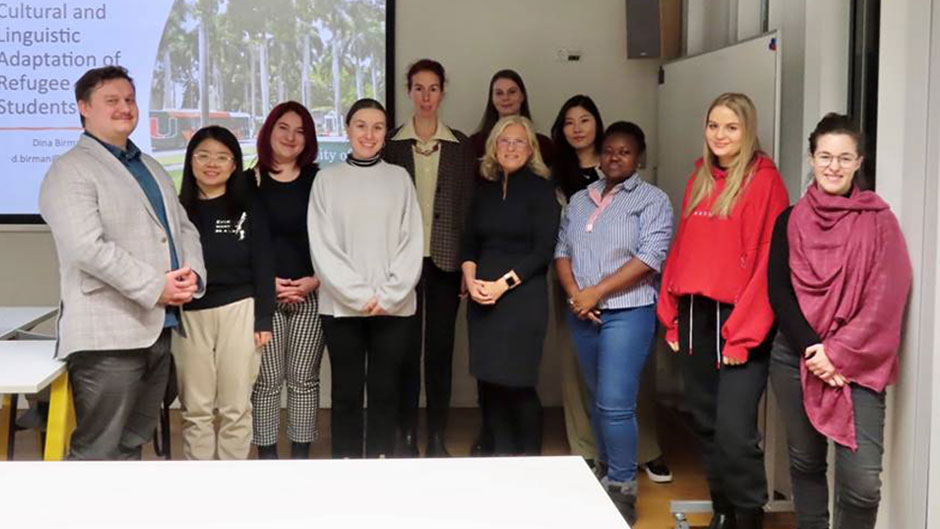Dina Birman always has been interested in how immigrant children acculturate to a new country and language.
As a 12-year-old immigrant herself, she had to learn English in Silver Spring, Maryland, and adapt to school in the United States after she and her parents left the Soviet Union during the height of the Cold War.
During the past academic year, she was a Fulbright Scholar in Tallinn, Estonia, a country that has welcomed thousands of Ukrainian refugees displaced by the war in their country.

The International Monetary Fund has reported that 62,000 Ukrainian refugees were accepted by Estonia, the highest number of refugees accepted by any European Union country, given its population.
"I wanted to understand the range of experiences that these children had in schools and the programs created to accommodate them," said Birman, a professor in the University of Miami School of Education and Human Development.
During her stay, she interviewed teachers, students, and their parents in seven schools, mostly concentrating on students enrolled in grades 7–12.
Most refugees came from Eastern Ukraine, where Russian is widely spoken. And the Russian speaking community is the reason why many Ukrainian refugees chose to come to Estonia, expecting an easier cultural and linguistic adjustment, according to Birman. In addition to Ukrainian, the refugees speak Russian or "Surzhyk," a blend of the two languages.
The Estonian school system mobilized to provide educational opportunities for the children, Birman noted. And she shared more about her experience in Estonia.
What were some of the most important goals that these schools had for the children?
All schools had three goals: to provide psychological safety, facilitate integration into Estonian language and culture, and create conditions for academic success of the students. However, different kinds of schools prioritized different goals; the goals were often in conflict with one another.
What were some of the major findings you discovered in your study of immigrant children who went from Ukraine to Estonia?
Children attended schools with Russian or Estonian as the medium of instruction. Also, because of the crisis, two Ukrainian schools were created for the children.
All the schools were doing tremendous work to integrate these students. However, it was done in different ways. To me, there is not one way to integrate as an immigrant and it is important that parents have options. In Estonia, because of the symbolic importance of having refuges learn the language, they wanted the kids to go to Estonian language schools.
In the Ukrainian schools, they really created a home away from home. There was a validation of trauma and the injustices that they underwent and the terrible crimes against them. However, there was the challenge of how do you help the children succeed in Estonia without knowing the Estonian language.
The Estonian schools had greater opportunities for acculturation but the number of kids in these schools was so small that it was hard for them socially.
In the Russian schools, it was different. They could come in and, in a short time, they could transition into the Russian language of instruction since Ukrainian and Russian are similar.
The problem in these schools was that there were teachers and students that were supporting Russia's invasion of Ukraine, so it was not a psychologically safe environment.
What was the most surprising finding you uncovered while doing this study?
The first thing that surprised me was the willingness to hire refugees, not only as paraprofessionals as sometimes done in the United States, but as teachers and as psychologists. Their diplomas were acknowledged, and the Estonian school system felt that it was important to integrate them into the school system. That was tremendous.
The second thing that surprised me is that in the U.S., we use "trauma-informed care" for children who have undergone trauma. That was not a term they used. Perhaps because Estonia does not have experience resettling refugees, teachers were not familiar with such practices and instead sent them to a psychologist.
What kind of lessons can we draw from the study that can be applied to our own immigrant population here in the U.S.?
The study identifies three goals that all schools in resettlement countries must address when incorporating refugees: safety, integration, and academic achievement.
In the long term, learning the new language and culture are necessary preconditions for immigrants to adapt academically and psychosocially in a new country. But this study shows how in the short term, integration, psychological, social, and academic adjustment unfold at the same time.
Schools, families, and students had to make difficult choices about which priorities to pursue. Refugee students do need to learn the new language, but also to have friends, and opportunity to learn and succeed at school.
Teachers and school administrators need to understand the trade-offs when balancing these goals and find ways to support all three.
Is there anything else you would like to share about your research?
I am writing a paper together with my colleague, Anastassia Zabrodskaya, professor of intercultural communication at the University of Tallinn, to be published in an academic journal. We also plan to disseminate our findings to schools in Estonia.






